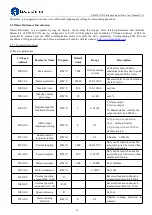
EM522-CAN Field bus Stepper Drive User Manual V1.0
24
RPDO4
1603H
TPDO4
1A03H
!
Notice
Not
es: (1) Recommend to reduce the quantity of using PDO unless it’s necessary, in order to reduce the network
load.
(3)PDO property
PDO need to configure multiple properties, including transport is synchronous or asynchronous, the length of prohibit time,
they are configured by modify corresponding address of the following chart.
RPDO
Address to Set
RPDO Properties
TPDO
Address to Set
TPDO Properties
RPDO1
1400H
TPDO1
1800H
RPDO3
1402H
TPDO3
1802H
RPDO4
1403H
TPDO4
1803H
The suggestion for setting PDO properties:
(1) Synchronous or asynchronous?
Synchronous transport means that the corresponding data of PDO will update when synchronization frame emerge on
data bus. It can bring stable data updating periodically, but can’t receive real-time change data.
Asynchronous transport means that update the data immediately once the data change, this way of transmission can
quick response, but easy to have larger data load on the bus in case of data changing frequently( such as real-time
position data). So you need to configure a prohibit time (the changing data can be updated in some time setting by
prohibit time, not transmitting repeatedly) to reduce network load.
Recommended to adopt synchronous PDO mode in case of the real-time data is necessary, but in the case of that he
real-time request is necessary, to adopt asynchronous PDO mode ,and set suitable prohibit time to protect the network
load from the shock.
(2) Synchronous cycle and asynchronous prohibit time settings
Recommended to calculate according to empirical formula:
Synchronizing cycle (ms)=[PDO amount/9] /(40%) +2
Assume that a CANopen network with a total of 12 axis, each axis has a send and receive PDO. The total number of the PDO
is 12 * 2 = 24. In case of bus full load, can transmit 9 PDO in a millisecond, considering the bus load margin, To assume that
the bus load is 40%(relatively reasonable load rate), the time required for transmit 24 PDO is: 24/9/(40%)=6.67(ms),
considering the network expenditure time of SDO, synchronous frame, heartbeat packets, Emergency packets etc. Add
extra 2 milliseconds, recommended configuration synchronization cycle to be 8.67 milliseconds.
Above empirical formula also apply to set asynchronous PDO prohibit time.
5.2.3 Service data object (SDO)
(1) SDO and PDO








































